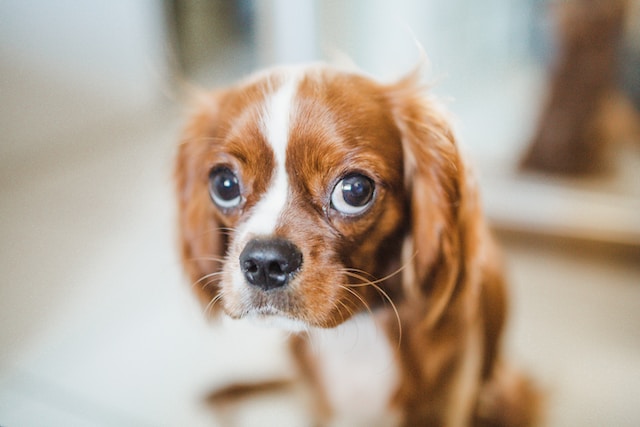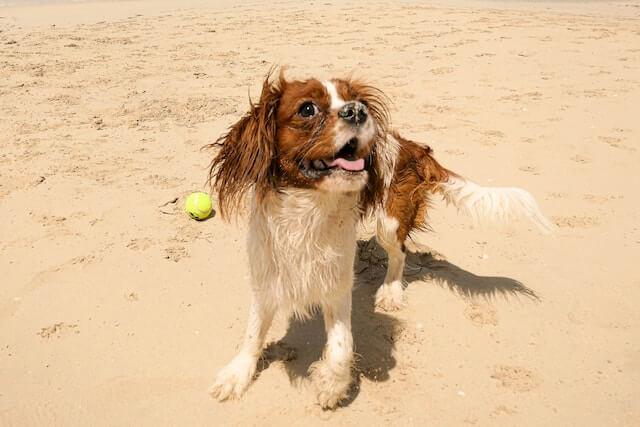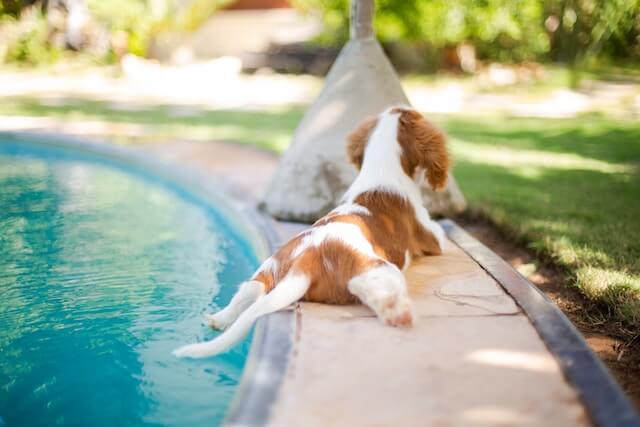Have you ever wondered what your Cavalier is trying to communicate with those big, adorable eyes or its graceful feathered tail? While our four-legged friends can’t speak, they do have various means of conveying their emotions and feelings.
This article is dedicated to exploring just that. By the time you finish reading, you’ll have a deeper understanding of the body language of Cavalier King Charles Spaniels.
Cavalier King Charles Spaniel Body Language
Facial Expressions and Head Movements

Cavalier King Charles Spaniels are known for their expressive faces, and by paying attention to their facial expressions and head movements, you can gain valuable insights into your dog’s state of mind.
Eyes:
- Bright, Alert Eyes: When a Cavalier’s eyes are wide open, bright, and focused, it usually indicates attentiveness and curiosity. This is a sign that they are engaged with their surroundings and possibly anticipating interaction.
- Soft, Relaxed Eyes: Soft eyes with a gentle gaze suggest contentment and relaxation. This expression is typically seen when your Cavalier is comfortable, feels safe, and is at ease in their environment.
- Avoidant or Averted Gaze: If your Cavalier avoids eye contact or averts their gaze, it may indicate shyness, discomfort, or submission. They may be trying to signal that they are not looking for direct interaction at the moment.
Ears:
- Perked Up Ears: When your Cavalier’s ears are upright and alert, it indicates heightened interest or excitement. They are likely focused on something specific in their environment and may be ready to investigate further.
- Flattened Ears: Flattened ears can signal discomfort, anxiety, or fear. This may occur if your Cavalier feels threatened or unsure about a situation. It’s important to approach them gently and provide reassurance.
- Pulled Back Ears: Ears that are pulled back against the head may mean that they are feeling friendly. However, if ears are laid tightly back on the head, it may indicate fear or submission. This posture suggests that your Cavalier is trying to appear smaller or less threatening.
Mouth and Lips:
- Relaxed Mouth: A slightly open, relaxed mouth with the tongue lolling out is a sign of contentment and comfort. It indicates that your Cavalier is at ease and enjoying their current environment.
- Panting: Cavalier panting may occur when it’s too hot or after physical activity, but it can also be a sign of stress or anxiety. Pay attention to the context to determine the cause.
- Showing Teeth: If your Cavalier shows their teeth without growling, it could be a sign of excitement or playfulness. However, if teeth are bared with growling, it’s a warning sign of discomfort or potential aggression.
Posture and Body Movements

A Cavalier King Charles Spaniel’s posture and body movements provide valuable insights into their emotional state and level of confidence. Here are a few to observe:
Tail Position:
- High Tail: When a Cavalier holds their tail high, it typically indicates confidence and alertness. This posture is often seen when they are excited, happy, or exploring a new environment.
- Low Tail: A low-hanging tail can signal submission or uncertainty. If your Cavalier’s tail is tucked between their legs, it suggests fear or anxiety.
Back and Stance:
- Arched Back: An arched back accompanied by raised fur can be a sign of fear, aggression, or defensiveness. It’s a protective posture often seen when a Cavalier feels threatened or uncomfortable. It might also be a sign of pain coming from a medical condition.
- Play Bow: In this posture, the Cavalier lowers their front end with their front legs’ knees touching the ground, while their rear end remains elevated. This is a universal dog signal for playfulness and an invitation to engage in social play. It’s a clear indication that your Cavalier is in a happy and playful mood.
Paw Movements:
- Pawing Behavior: If your Cavalier gently paws at you, it’s often a sign of affection and a way to seek attention. They may be looking for interaction, play, or simply some pets and cuddles.
- Pacing or Restlessness: Continuous pacing or restlessness may indicate restlessness or a need for mental or physical stimulation. It’s a signal that your Cavalier may benefit from engaging in activities or a change in their environment.
Vocalizations and Sounds

While Cavalier King Charles Spaniels are not overly vocal dogs, they may use different sounds to communicate their needs, emotions, and reactions to their environment. Understanding your Cavalier vocal cues can help you respond appropriately and address their concerns.
Barking and Growling:
- Alert Barking: This is a sharp, quick bark used to draw attention to something in their environment. It may indicate excitement or a desire to alert you to a potential stimulus.
- Playful Barking: A series of rapid, high-pitched barks often accompanied by a wagging tail. This indicates excitement and eagerness to engage in play.
- Growling: While growling can sometimes be a sign of discomfort or aggression, in play, it’s usually softer and accompanied by relaxed body language. It’s a way for your Cavalier to express enthusiasm.
Whining and Crying:
- Whining for Attention: Your Cavalier may whine when they want your attention, whether it’s for play, food, or simply companionship. This is usually a higher-pitched sound expressing eagerness.
- Whining Due to Discomfort: If your Cavalier is experiencing discomfort, such as being too hot or needing to go outside, it may whine to let you know.
- Crying in Distress: This is a more urgent and persistent vocalization that may indicate your Cavalier is in distress or in need of immediate attention.
Howling:
- Loneliness or Communication: Howling is a form of vocalization that can indicate loneliness or a desire to communicate with other dogs. It’s important to distinguish this from distress or discomfort.
Playful Vocalizations:
- Excited Chirping or Chattering: Some Cavaliers may make chirping or chattering sounds, particularly when observing birds or small animals. This is often an expression of excitement and curiosity.
Understanding Tail Wagging

A dog’s tail is one of their most expressive features. The Cavalier tail position can convey a range of emotions and intentions. When you pay attention to the direction and speed of your pet’s tail, you can understand what your pet is trying to tell you.
Direction and Speed:
- Side-to-Side Rapid Wagging: When your Cavalier wags their tail high and rapidly, it often indicates excitement and happiness. This is a clear sign that they are in a positive and enthusiastic mood.
- Low, Slow Wagging: A slow, low wag can indicate uncertainty or mild discomfort. Your Cavalier may be unsure about a situation or feeling a bit cautious.
Other Tail Behaviors:
- Tucked Tail: If your Cavalier tucks their tail between their legs, it’s a sign of fear or submission. This may happen in stressful or unfamiliar situations.
- Stiff Tail: A stiff tail held in a horizontal position can indicate alertness or heightened focus. Your Cavalier may be paying close attention to something in their environment.
- Curled Tail: A gently curved tail is a sign of contentment and relaxation. Your Cavalier is comfortable and at ease.
Interaction with Other Body Language:
- Pay attention to how tail wagging combines with other body language cues, such as facial expressions, ear position, and overall posture. This will give you a more complete picture of your Cavalier’s emotional state.
